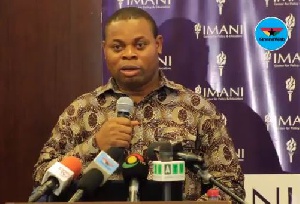IMANI Centre for Policy and Education has blamed the creation of the Office of Government Machinery (OGM) as the sole reason for government’s desire to overly appoint public officers especially Presidential staffers.
"In actual fact, what is responsible for the current state of affairs has been with us since we created a creature called the the Office of Government Machinery (OGM)," a statement from the policy think tank said.
"We have been down this road before and IMANI did advice the current government to avoid pitfalls it is dealing with right now. The numbers are just but one part of the story. The frighteningly morbid part is the gargantuan expenditure on some needless entities created for the OGM" it added.
President Akufo-Addo on Friday forwarded a list of 998 employees at the Presidency to Parliament. This was in compliance with Section 11 of the Presidential Office Act, 1993 (Act 463), which requires the President to submit annually to Parliament, a report on the staffing position of the Office of the President.
Shocked by the numbers, some Ghanaians accused Akufo-Addo of abusing public purse but government says majority of the staff at the Office of the President, was inherited from the former government led by John Dramani Mahama.
IMANI’s worries lie more with the huge cost component and budgets overruns that accompany the majority of these appointments, ranging from compensation to goods and services.
A year-on-year analysis by IMANI shows that the Office of Government Machinery maintains a consistent pattern of budget overruns, at a rate higher than most other parts of the government.
The overruns are sometimes as high as double the total allocations to the office in both elections and non-election years.
In a statement posted on Facebook, IMANI states that “Expenditure over the years studied exceeded allocations for most of the expenditure items at the OGM especially in respect of personnel remuneration and procurement of goods and services. In 2012, the OGM exceeded allocations to compensation and procurement of goods and services by GHS 202,899,157 and GHS 99,166,449 respectively.”
In 2016, the NDC planned to spend GHC768.1 m on the Office of Government Machinery. A supplementary budget adjusted it upwards to almost GHC3 billion but, ended up spending more than GHC6.1 billion - an overrun of nearly GHC3bn. In 2017, the NPP planned to spend GHC1.5bn on the Office of Government Machinery. The auditor’s report yet to reveal actual expenditure.
Read the full statement below
There has been so much written and said by many on the 998 staff and counting at the presidency. In actual fact, what is responsible for the current state of affairs has been with us since we created a creature called the the Office of Government Machinery (OGM). We have been down this road before and IMANI did advice the current government to avoid pitfalls it is dealing with right now. The numbers are just but one part of the story. The frighteningly morbid part is the gargantuan expenditure on some needless entities created for the OGM.
The Office of Government Machinery (OGM), is an amorphous receptacle hosting such agencies as the Office of the President, Office of the Head of Civil service, National Security, assorted Commissions and a potpourri of ‘councils’ of all kinds. Today, it has more nebulous entities.
1. Take a close look at the figure 1. You no doubt must have noticed a consistent pattern of budget overruns, at a rate higher than most other parts of the government, associated with this OGM budget line. The overruns are sometimes as high as double the total allocations to the office. What is causing these consistent and high levels of budget overruns at the OGM? AND THESE INCLUDE ELECTION AND NON-ELECTION YEARS!
2. As shown in figure 2, expenditure over the years studied exceeded allocations for most of the expenditure items at the OGM especially in respect of personnel remuneration and procurement of goods and services. In 2012, the OGM exceeded allocations to compensation and procurement of goods and services by GHS 202,899,157 and GHS 99,166,449 respectively.
3. A study of table 2 below raises the question of whether the level of transparency at the OGM is adequate. How prudent was the OGM if it was able to spend an extra GHS 256,422,166 above its allocated amount of GHS 350,040,522 in 2014? How was the OGM able to fund this difference without raising eye brows? Is this an issue of sloppiness and a lack of commitment to proper planning? Or is it a total disregard for laid-out rules and procedures? Is Ghana going to continue a trend of elaborate formulation of policies but with very little implementation? Are Ghanaian taxpayers ever going to get value for money?
4. What exactly is wrong to suggest that strictly applying PLANNED EXPENDITURE metrics, the NPP's figures compared to the NDC 's in 2016 is double? The NDC planned to spend GH¢768.1 m on the Office of Government Machinery in 2016, but a supplementary budget adjusted it upwards to almost GH¢3 billion but, ended up spending more than GH¢6.1 billion an overrun of nearly GH¢3bn.
In 2017, the NPP planned to spend GH¢1.5bn on the Office of Government Machinery. Notice a doubling of the NDC's planned expenditure in 2016. We are yet to know the overruns from the Audit report for 2017.
The overruns may not be as high as we saw in 2016 as it was an election year( typical of all governments- spending foolishly) . In 2018, the NPP plans to spend GH¢3bn on the Office of Government Machinery. ONCE AGAIN ON PLANNED EXPENDITURE.
What is even egregious is the suggestion by some NPP folks that the special development ministry's planned budget of nearly Ghc 2bn should be isolated and treated as CAPEX when in actual fact, the reality is that the ministry seats under the direct nose of the president constituting a substantial part of the office of government machinery. And that is what we are actually comparing- the planned expenditures of the Offices of Government Machinery under the NDC and NPP. What I did with references of out turns with the NDC is to suggest that planned expenditures usually are not respected. So yes, we can wait for the ouuturns for the NPP but it does NOT negate the fact that there has been a doubling of PLANNED EXPENDITURE!.
5. It is not very difficult to see what is going on: the highest office of the Land and its occupant has become a shield preventing deeper probing into strange misallocations and misspending running into tens of millions of dollars at the heart of government. How did this happen?
Firstly, an overload of good intentions. The justification for this amorphous structure was provided by the Presidency in 2014 to Parliament as follows: “The Office of Government Machinery comprises the Office of the President as the seat of Government, the National Security Council Secretariat and agencies under it, the 10 offices of the Regional Co-ordinating Councils, including the Regional Budget Offices and some organisations which do not fall under the existing sectoral delineations, and have therefore, been placed under the Presidency for the supervision and coordination of their work.”
The first thing to notice is a lack of both imagination and rigour. If something doesn’t fit neatly into what is called a “sectoral delineation”, then the thinking is: dump it at the Presidency. The second thing to notice is that there is no institutional coherence in all this. No thinking has gone into how best to maintain efficiency in this random, tossup, salad.
Thirdly, incongruity. Why should regional coordinating councils not be coordinated and managed by the Ministry of Local Government (or whatever its latest name is) or the National Security Council Secretariat hosted by the Ministry of National Security? The fact that there are inter-agency factors does not mean that facilities and personnel cannot be hosted within a well-defined institutional home, like a Ministry. Such ‘hosting’ is common in governments around the world that deal with sophisticated inter-agency affairs all the time.
There is absolutely no reason why within its existing budget the Ministry of Education cannot take care of the Scholarships Secretariat, or why the Ministry of Information cannot assume responsibility for the National Archives. Why should the MASLOC, with its puny microfinance program, be placed under the Presidency?
Due to this confusing mashup, we today have the Presidency of Ghana currently involved in supervising poultry farmers in the sale of eggs, distributing fishing nets, and promoting condoms, all at highly inflated costs!
Under the current administration, the OGM in addition to many pre-existing entities, now include the following; 1. Free SHS Secretariat 2. Ministry of Inner Cities and Zongo Development 3. Ministry fo Business Development 4. Ministry of Regional Reorganization 5. Ministry of Special Development 6. Ministry of Procurement 7. Ministry of Monitoring and Evaluation 8. Ministry of Planning 9. One District, One Factory
It is not surprising that some of the biggest scandals we have seen took place in agencies locked in this OGM structure, such as SADA.
To tame this runaway OGM horse before it leaves the stable, the following actions are critical:
1. Immediately take steps to rationalize the agencies placed within this poorly coordinated structure and reduce the number of entities reporting directly to the President to the bare minimum. Many of the mandates can be aligned with Ministerial mandates and placed in tighter reporting systems within the Ministries.
2. Outline plans and strategies to reverse the practice of overspending and establish key indicators that the public can hold government agencies accountable to. Reasons for any overspending should be clearly explained in audit reports which should be timely and available to the public.
3. Implement an institutional audit to remove redundancies like the Ghana AIDs Commission, whose role can fit cleanly within existing infectious disease programs at the Ministry of Health. The institutional audit should be followed by a financial restructuring with the aim of saving $50 million by 2018. With competitive procurement and a dedicated financial management system across the leaner remnant of the reformed OGM, 40% of the OGM budget in the last financial year can be shaved off.
4. To galvanise the political will for these drastic reforms, radical transparency is required. The government should proceed to publish the contracts awarded in the various units within the Presidency and redact only the sections of national security contracts of proven sensitivity.
General News of Monday, 23 April 2018
Source: www.ghanaweb.com

















